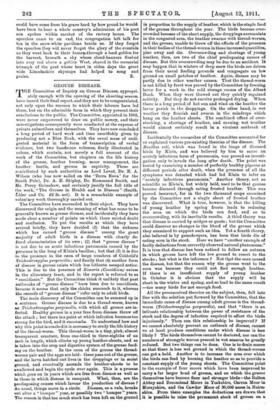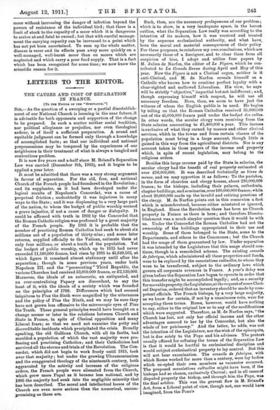GROUSE DISEASE.
THE Committee of Inquiry on Grouse Disease, appropri.. ately enough with the opening of the shooting season, have issued their final report, and they are to be congratulated, not only upon the success to -which their labours have led them, but on the admirable form in which they present their conclusions to the publio. The Committee, appointed in 1905, were never empowered to draw on public money, and their mvestigations consequently were conducted at the expense of private subscribers and themselves. They have now concluded a long period of hard work and time unselfishly given by producing not a Blue Book, with the usual mass of undi- gested material in the form of transcription of verbal evidence, but two handsome volumes, finely illustrated in colour, which contain, not merely a full account of the work of the Committee, but chapters on the life history of the grouse, heather burning, moor management, the heather beetle, and grouse in captivity. These are contributed by such authorities as Lord Lovat, Dr. E. A. Wilson (who has now sailed on the ' Terra Nova' for the South Pole), Dr. A. E. Shipley, Dr. Hammond Smith, and Mr. Percy Grimshaw, and certainly justify the full title of the work, " The Grouse in Health and in Disease " (Smith, Older and Co. £2 2s. net). It is a remarkable example of voluntary work thoroughly carried out.
The Committee have succeeded in their object. They have discovered the origin and the meaning of what has come to be generally known as grouse disease, and incidentally they have made clear a number of points on which there existed doubt and confusion. To put the results at which they have arrived briefly, they have decided (1) that the sickness which has caused "grouse disease" among the great majority of adult birds is a disease with clearly de- fined characteristics of its own ; (2) that "grouse disease" is not due to an acute infectious pneumonia caused by the presence in the lung of Klein's bacillus ; but that (3) it is due to the presence in the caeca of large numbers of Cobbokl's Trichostrongylus pergracilis ; and finally that (4) another form of disease in grouse exists which has hitherto escaped notice. This is due to the presence of Eitneria (Coccidium) avium in the alimentary tract, and in the report is referred to as
coecidiosia." But the Committee think it unlikely that past outbreaks of "grouse disease" have been due to coccidiosis, because it seems that only the chicks succumb to it, whereas the records of " grouse disease " refer only to adult birds.
The main discovery of the Committee can be summed up in a sentence. Grouse disease is due to a thread-worm, known as Trichostrongylus pergracilis, with which all grouse are in- fected. Healthy grouse in a year free from disease throw off the attack ; but there is a point at which infection becomes too strong for the bird, and it succumbs. To understand how and why this point is reached it is necessary to study the life history of the thread-worm. This thread-worm is a tiny, pink, almost transparent creature, from one-third to three-eighths of an inch in length, which climbs up young heather-shoots, and so is taken into the crop and digestive system of the grouse feed- ing on the heather. In the ca:ca of the grouse the thread- worms pair and the eggs are laid : these pass out of the grouse, and the larva hatched out lives in the droppings or in moist ground, and eventually ascends the heather-shoots to be swallowed and begin the cycle over again. This is a process which goes on in years which are free from disease as well as in those in which disease is rampant. What, then, are the predisposing causes which favour the production of disease ? As usual, things move in a circle. Disease, as a rule, breaks out after a " bumper " year, or possibly two " bumper " years. The reason is that too much stock has been left on the ground in proportion to the supply of heather, which is the staple food of the grouse throughout the year. The birds become over- crowded because of the short supply, the droppings accumulate in the congested area, the heather swarms with thread-worms, and the grouse, unable to throw off the effects of the presence in their bodies of the thread-worms in these increased quantities, pine away and die. Overcrowding and shortage of young heather, then, are two of the chief predisposing causes of disease. But this overcrowding may be due to an accident. It may happen that in winters of deep snow the birds are driven from their usual feeding grounds and congregate on low ground on small patches of heather. Again, disease may be partly due to other weather causes. That the thread-worm is not killed by frost was proved by the Committee by freezing larvae for a week in the cold storage rooms of the Albert Dock. When they were thawed out they quickly regained activity. But they do not survive prolonged drying. When there is a long period of hot sun and wind on the heather the larvae perish in the droppings. On the other band, in wet weather they flourish and swarm in the raindrops which hang on the heather shoots. The combined effect of over- stocking, a shortage of heather, and ensuing wet weather would almost certainly result in a, virulent outbreak of disease.
Incidentally the researches of the Committee accounted for or explained various pre-existing theories of the disease. The Bacillus coli, which was found in the lungs of diseased birds by Klein, and was believed by him to cause an acutely infectious form of pneumonia, was proved on investi- gation only to invade the lung after death. The point was tested by examining a number of perfectly healthy pigeons at different periods after death, when the presence of all the symptoms was detected which had led Klein to infer an "acutely infectious pneumonia." Another theory, not so scientific as Klein's, but widely held, used to be that grouse became diseased through eating frosted heather. This was proved incorrect, for in the two thousand crops examined by the Committee not a single shoot of frosted heather was discovered. What is true, however, is that the killing of young heather by spring frosts leads to reducing the area on which the birds can feed, and so to overcrowding, with its inevitable results. A third theory was that disease is carried by midges or gnats ; but the Committee could discover no changes in the blood of the grouse which they examined to support such an idea. Yet a fourth theory, also believed in by gamekeepers, has been that birds die of eating corn in the stook. Here we have "another example of faulty deductions from correctly observed natural phenomena." It is true that disease has been noticed to follow an autumn in which grouse have left the low ground to resort to the stooks ; but what is the inference P Not tlett the corn caused the disease, but that the reason why the grouse went to the corn was because they could not find enough heather. If there is an insufficient supply of young heather in October it is obvious that the supply will be short in the winter and spring, and so lead to the same result —too many birds for not enough food.
All the preconceived theories on the subject, then, fall into line with the solution put forward by the Committee, that the immediate cause of disease among adult grouse is the thread- worm (Trichostrongylus pergracili8), and that "there is an intimate relationship between the power of resistance of the stock and the degree of infection required to affect the birds injuriously." Then can this relationship be improved ? If we cannot absolutely prevent an outbreak of disease, cannot we at least produce conditions under which disease is less likely ? The birds themselves cannot be doctored, nor can the numbers of strongyle worms present in wet seasons be greatly reduced. But two things can be done. One is to drain moors so that there is less wet ground in which the thread-worms can get a hold. Another is to increase the area over which the birds can feed by burning the heather so as to provide a constant supply of the young shoots. The Committee point to the example of four moors which have been improved to carry a far larger head of grouse, and on which the grouse themselves have become finer and stronger birds—the Bolton Abbey and Broomhead Moors in Yorkshire, Carron Moor in Morayshire, and the Cawdor Moor of 30,000 acres in Nairn- shire. From these examples the deductions are drawn that it is possible to raise the permanent stock of grouse on a
moor without increasing the danger of infection beyond the powers of resistance of the individual bird ; that there is a limit of stock to the capacity of a moor which it is dangerous to arrive at and fatal to exceed ; but that with careful manage- ment the carrying capacity can be increased to a point which has not yet been ascertained. To sum up the whole matter, disease is rarer and its effects pass away more quickly on a well-managed, well-burnt moor than on moors which are neglected and which carry a poor food supply. That is a fact which has been recognized for some time; we now know the scientific reason for it.



































 Previous page
Previous page